Thirty-two of the 700 photos the artists submitted were chosen for the exhibit, substantial enough to get a vividly diverse picture of everyday life in Lhasa, as well as reveal unexpectedly rare facets that help to ground our perception of Tibetan life. Who would have expected to discover a photo capturing a Tibetan Muslim festival? Or an ancient mosque, a small boy in Tibetan festival finery and typical headdress, or Muslim women clad in the chador? The curator discreetly mentions that even provincial governors had attended this event.
The photos were displayed at the World Culture Museum, Frankfurt am Main, Germany.
Islam Alongside Buddhism in Lhasa
One contributor to the exhibit is Suo Mani, a Muslim artist, who is a painter, and now a photographer, as well. He studied at the art school in Lhasa, the town where he also lives. He is a member of a large Muslim group, that migrated from Kashmir centuries ago and that ended up settling in Tibet. The descendants from the original group continue to live peacefully alongside their primarily Tibetan Buddhist neighbors
A series of three images from another artist chronicle the deterioration of the famous Drepung Buddhist Monastery, which was once formerly a highly respected university. The monastery of antiquity, also a revered destination for pilgrims, has since been reduced to a mere open-air museum. Red arrows mark the way for tourists.
Up until 1959, the monastery was home to 10,000 monks—now it houses at most, several hundred. Significant losses were incurred during the Chinese Cultural Revolution (1966-1976). Not even Deng Xiaoping’s liberalization and a period of relative calm could restore the monastery’s former glory. Since then, tensions between Tibetans and communist officials have only continued to mount.
Modern Means Exist Beside Traditional Ways
Are tradition and modern technology antithetical in present day Tibet? Several exhibition photos attest to the contrary! We seldom perceive the multi-layered strata that make up modern Tibetan society for what it truly is; some even view emerging reports of violent repression as fiction.
One photo image from daily life shows a man and a woman sitting at a table. She has a thermos bottle in front of her, while he has a traditional bowl of buttered tea. She reads from Buddhist texts, while the man holds a cell phone to his ear. (Ruler Songtden from the Greater Tibetan Kingdom had developed the standardized Tibetan scriptures in the 7th century.)
Cell phones are the current rage in Tibet, with every Tibetan owning at least one, including nomads, according to exhibit curator, Elke Hessel. She is an academic advisor/aide at the Tibethaus Deutschland e.V. (as registered in Germany.) She has close, long-time ties with the artists, and had encouraged them to submit their photos.
A perfect example of tradition juxtaposed next to modern life is the photo “Grandmother and Grandson.” The two sit next to each other in front of a house, with the grandmother in her traditional sleeve protectors, paring a pear, and the boy in a jogging suit, reading a comic book. Why is he wearing a jogging suit? It is compulsory school attire in the nearly always severely cold Lhasa.
Globalization’s cheap inroads are evident here, as the photo, “Small Child with a Doll” illustrates. The doll has Western features and is almost as large as the child, who peers perplexedly into the camera. “Toys” as we know them, are something new to Tibet.
Horse festivals are still much beloved at the Roof of the World, even though the dust can be stifling. Speed and skill are essential in these events. One event involves a skilled rider atop a horse galloping at top speed, while retrieving a white piece of cloth [katak: a Tibetan ritual cloth]. The rider must also be able to perform other artistic and acrobatically challenging stunts on horseback.
One photo shows colorfully adorned horses and riders—the pride and joy is palpable. The image is hung next to a picture of the artist, his arms extended in a gesture not typically Tibetan, which was taken in front of the “Bird’s Nest” during the 2008 Olympics. His demeanor conveys his ambivalence.
Art Gives Voice to a Yearning for Freedom
A few photographers used their art as a means to express their longing for Tibet’s freedom from communist rule. One such piece has an image of a bright red cage, above which an eagle soars. Imprisoned in the communist party’s red cage – is the eagle perhaps a symbol of longed-for freedom? Even though the artist may have openly wanted to express this sentiment, he declines comment. The danger of a repressive regime curtailing his artistic endeavors is all too real.
Another exhibited image is a self-portrait of the artist taking a photo, which was put in a see-through glass bottle. In spite of his arms being bound, he throws butterflies covered with Tibetan inscriptions into the air within the bottle. The bottle is swathed with a red fabric, symbolic of the red kerchief worn by the “Young Pioneers,” a communist party youth organization. It it is a reminder of the influence the communist party exerts over young, malleable minds.
A Profound Love for Tibet
A Chinese woman is also a contributing artist. She is an avid supporter of Tibetan culture, and has lived and worked in Lhasa since 2001. Her preferred subject to document is the oppression of women. She had just staged a scene to photograph—two naked mannequins she had artistically painted and propped up on the road—when a small group of pilgrims on a long journey arrives.
One click forever immortalizes the scene: one of the pilgrims, with an innocent smile, spontaneously drapes his arm around the naked mannequin. A documentary for happy impartiality, something quite typical for most Tibetans, so expressed Elke Hessel.
Tibetans love their land, and notwithstanding, most of them speak more or less fluent Mandarin Chinese, in addition to their native tongue. Even though they have studied at Chinese universities, they invariably tend to return to their home turf, with hopes of aiding its progress.
This demonstration of love might on occasion take the form of participating in a movement of holding light-hearted signs up all over Lhasa. One of the artists captured this innocent pastime in a photo. The sign reads, “I am fond of oxygen deficiency,” alluding to the special climatic condition those living just under The Roof of the World are faced with.
Read the original German article.

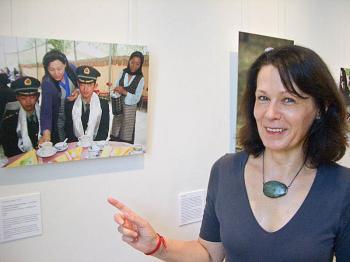
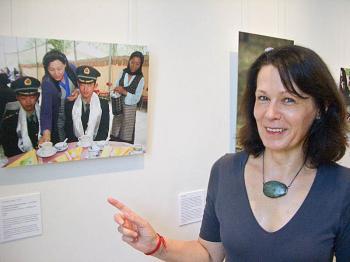
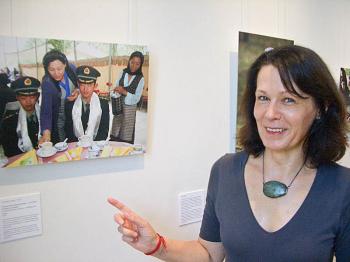
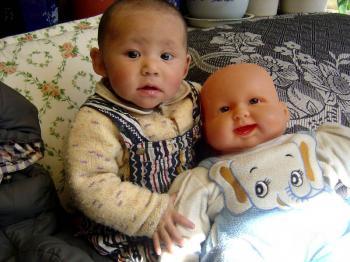
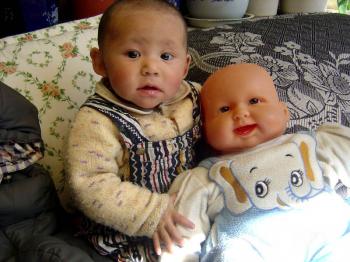
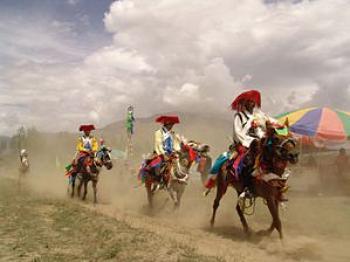
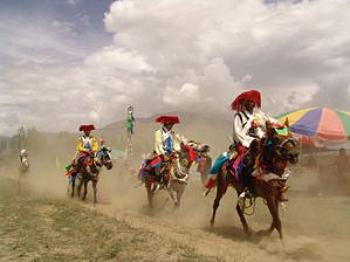





Friends Read Free